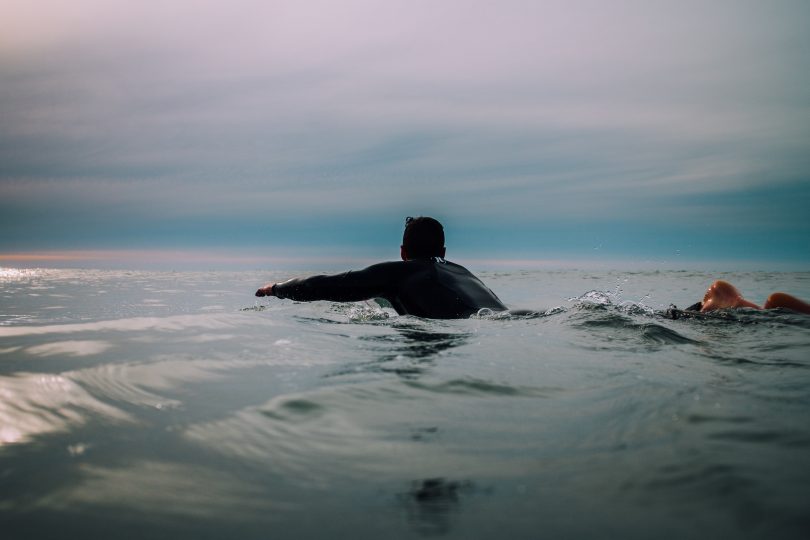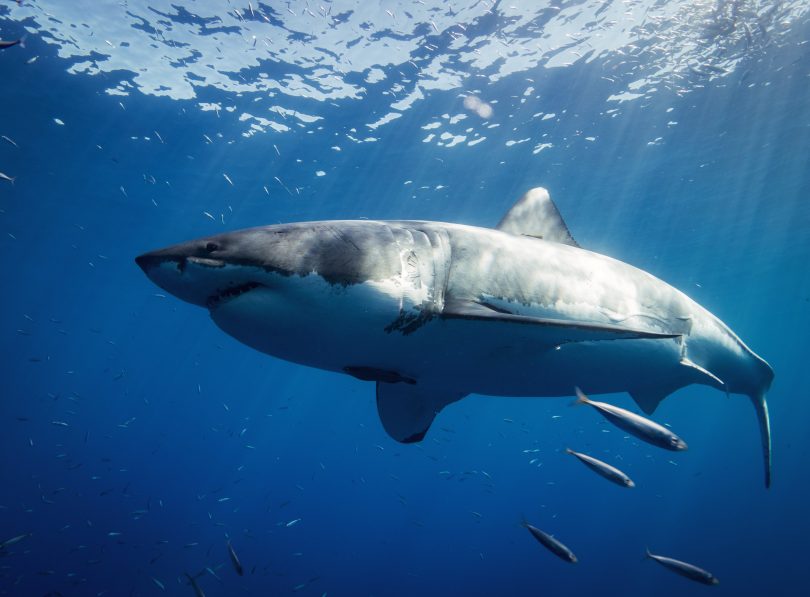
Surfers were swimming above sharks at North Broulee Beach last summer. Photo: Tim Marshall.
The patches of warm weather are growing, which means thousands of Canberrans will be getting their swimmers out in preparation for a trip to the beach as soon as COVID-19 restrictions allow.
So there’s no better time to talk about shark attacks.
In 2020, it was the worst year for shark attacks in nine decades, with eight Australians being killed by sharks in waters off NSW, Queensland and Western Australia, including former Canberra real estate agent Nick Slater.
The Australian National University (ANU) has discovered a simple first-aid technique for shark attacks that could help avoid fatalities this summer.
The method involves a bystander using their bodyweight to make a fist and ‘push hard between the hips and the bits’.
Lead author, surfer, emergency physician and Associate Dean of the ANU Medical School, Dr Nicholas Taylor, said the method reliably stops or reduces blood loss by using immediately available resources to treat lower limb haemorrhage.
“In shark attacks, most people don’t actually get bitten twice and they can make it back to the shore,” said Dr Taylor.
“I thought, if you make it to the beach with a friend and they’re bleeding from the leg, what would be the best thing you could do?

Dr Nicholas Taylor from the ANU Medical School is a keen surfer. Photo: Australian National University.
“I knew from my background in emergency medicine if people have massive bleeding from their leg, you can push very hard on the femoral artery and you can pretty much cut the entire blood flow of the leg that way.
“If someone has been bitten on their leg, you only need to find the middle point between the hip and the genitals, make a fist and push as hard as you can.
“We found people can do this for a long period of time, and making a fist covers the area you need. It’s not hard to find. It could even be marked with an X on a wetsuit.”
A traditional leg rope tourniquet can stem blood flow by 43.8 per cent, while a well-placed fist can stop 89.7 per cent of blood flow on average.
“Most people could completely stop all blood flow,” said Dr Taylor. “This new method saves time and works better than using a leg rope or looking for something else to use as a tourniquet.”
So far in 2021, there have been six unprovoked shark attacks in Australia, resulting in two fatalities and two others escaping with injuries. One was unharmed.

Great white sharks (pictured) and tiger sharks are the most commonly sighted species of sharks on the NSW South Coast. Photo: Gerald Schombs.
Last summer saw busy shark activity on the NSW South Coast, with 50 of them sighted in the waters between Moruya and Broulee in November 2020, followed by more in December as a whale carcass floated close to the coast, and another 10 seen swimming below surfers at North Broulee Beach on 13 January.
Experts suspect the La Nina weather pattern may have been partly to blame, as warmer ocean currents push fish towards the colder shore lines, subsequently attracting predators.
However, with that said, shark attacks remain very rare and Surf Life Saving Australia has several recommendations to ensure it stays that way.
“Don’t swim after dusk, at night or before dawn when sharks are most active,” states the organisation.
“Never swim alone. Never swim while bleeding or with your pets. Sharks have an excellent sense of smell and will come from far and wide to investigate these smells.
“Don’t swim in murky waters, estuary mouths, canals, near schools of fish or where fish are being cleaned.
“Many patrolled beaches along the coast have nets suspended in the sea just beyond the surf line. Their job is to capture very large and possibly dangerous sharks that try to reach beaches. You might see a line of white marker buoys beyond the waves that mark the nets. Stay away from them.”
As a keen surfer, Dr Taylor has watched in fear as dark masses pass beneath him, but says panic is the worst enemy to anyone who finds themselves in the water with a shark.
“You’d like to think you’ll be a lot more calm than you are, but sharks respond to splashing water and signs of distress,” he said. “You don’t want to look like an injured seal.”
The expert advice is to swim in a group and stay in close proximity to each other. If a shark is spotted, return to the beach as calmly as possible.
The NSW Government has committed to spending $8 million on a new strategy to detect and deter sharks, including ‘SMART drumlines’ and nets. Drone surveillance will also be used in collaboration with surf lifesavers along the NSW South Coast.












